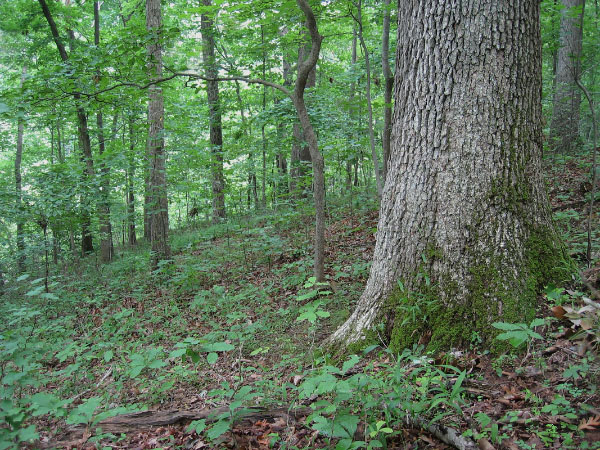
 የጥበቃ እና መዝናኛ መምሪያ
የጥበቃ እና መዝናኛ መምሪያ መጠበቅ. መከላከል. መደሰት.
 የጥበቃ እና መዝናኛ መምሪያ
የጥበቃ እና መዝናኛ መምሪያ  ማውጫ
ማውጫአሲዲክ ኦክ - የሂኮሪ ደኖች
Forests in this group are similar to those of the Basic Oak-Hickory Forests, but occupy submesic to subxeric upland sites with soils weathered from subacidic parent material such as siltstone, metasiltstone, shale, certain granites, and various metamorphic rocks. These forests are widely distributed throughout the Piedmont, mountain valleys, and lower mountain slopes of both the Blue Ridge and Ridge and Valley, up to about 600 m (2,000 ft) elevation. They were probably once also frequent in better soils of the Coastal Plain, but now only widely scattered remnants remain there. Hickories (Carya spp.) are less abundant than in the Basic Oak-Hickory Forests group but are nevertheless common, often primarily as understory trees. Dominant oaks include white oak (Quercus alba), black oak (Quercus velutina), scarlet oak (Quercus coccinea), northern red oak (Quercus rubra), southern red oak (Quercus falcata), and chestnut oak (Quercus montana). Flowering dogwood (Cornus florida) is a characteristic, often abundant understory tree, although its numbers have been greatly reduced in recent decades by the fungal pathogen dogwood anthracnose (Discula destructiva). Deciduous ericads, especially lowbush blueberry (Vaccinium pallidum) and deerberry (Vaccinium stamineum), are usually present but patchy in the shrub layer, along with maple-leaved viburnum (Viburnum acerifolium). Herbaceous diversity is somewhat less than in Basic Oak-Hickory Forests but considerably greater than in Oak/Heath Forests. Typical herbs of these communities include plaintain-leaved pussytoes (Antennaria plantaginifolia), Pennsylvania sedge (Carex pensylvanica), whorled coreopsis (Coreopsis verticillata), poverty oatgrass (Danthonia spicata), common dittany (Cunila origanoides), rattlesnake weed (Hieracium venosum), large summer bluets (Houstonia purpurea), low St. Andrew's cross (Hypericum stragulum), whorled loosestrife (Lysimachia quadrifolia), violet woodsorrel (Oxalis violacea), gray beard-tongue (Penstemon canescens), solomon's-seal (Polygonatum biflorum var. biflorum), lion's foot (Nabalus serpentarius), wild pink (Silene caroliniana var. pensylvanica), silverrod (Solidago bicolor), wavy-leaved aster (Symphyotrichum undulatum), and wood vetch (Vicia caroliniana).
አሲዳማ የኦክ-ሂኮሪ ደኖች በሥነ-ምህዳራዊ ሁኔታ መካከለኛ ናቸው ዝርያ ባላቸው መሠረታዊ የኦክ-ሂኮሪ ደኖች እና የአበባ በረቀቀ የኦክ/ሄዝ ደኖች መካከል። ከመሠረቱ የኦክ-ሂኮሪ ደኖች ያነሰ ለም አፈርን ይይዛሉ እና ዝቅተኛ ዝርያ ያላቸው-ሀብታሞች እና ብዙ ቁጥቋጦዎች አሏቸው። ከMontane Oak-Hickory Forests የሚለዩት በዝቅተኛ ከፍታ ወይም submontane መኖሪያዎች ላይ በመገደባቸው እና ተጓዳኝ ጥንቅር በአብዛኛው ከፍ ያለ ቦታ ላይ የማይገኙ ዝርያዎችን ያቀፈ ነው። ብዙ የአሲዲክ ኦክ-ሂኮሪ ደኖች በእሳት ማግለል ውጤቶች እየተሰቃዩ ነው ፣ ደካማ የኦክ ምልመላ እና እሳትን የማይቋቋሙ የሜሶፊቲክ ዝርያዎችን እንደ ቀይ የሜፕል (Acer rubrum) ፣ የአሜሪካ ቢች (ፋጉስ ግራንዲፎሊያ) እና ብላክጊም (ኒሳ ስሊቫቲካ) ወረራ ጨምሮ።
ማጣቀሻዎች፡ ፍሌሚንግ (2002ለ)፣ ፍሌሚንግ (2007)፣ ፍሌሚንግ እና ኩሊንግ (2001)፣ ፍሌሚንግ እና ሙርሄድ (2000)፣ ፍሌሚንግ እና ፓተርሰን (2004)፣ Gemborys (1974)፣ ኦልሰን እና ሁፕ (1986)።የዚህን የስነምህዳር ማህበረሰብ ቡድን ተጨማሪ ፎቶዎች ለማግኘት እዚህ ጠቅ ያድርጉ ።
 © DCR-DNH, ጋሪ ፒ. ፍሌሚንግ.
© DCR-DNH, ጋሪ ፒ. ፍሌሚንግ.
 ከታች ለተዘረዘሩ የማህበረሰብ አይነቶች የአቀማመጥ ማጠቃለያ ስታቲስቲክስ ወረቀት ያውርዱ.
ከታች ለተዘረዘሩ የማህበረሰብ አይነቶች የአቀማመጥ ማጠቃለያ ስታቲስቲክስ ወረቀት ያውርዱ.

